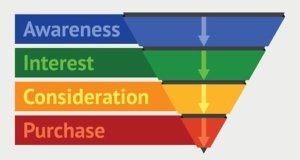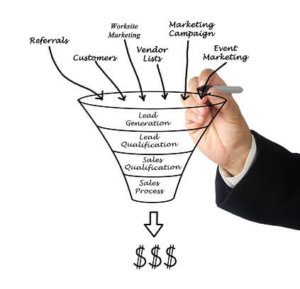Although content is king, inbound marketing’s real breadwinner is the sales funnel. By learning the secrets of this proven strategy, you can transform your website into a conversion-making machine.
What is a Sales Funnel?
An online sales funnel, which is also known as a conversion funnel, is a path that is created to entice website visitors into becoming paying customers. This sales method is described as a funnel, because the number of prospects decreases dramatically at each stage. Typically, only a fraction of website visitors become qualified leads. But, that is actually beneficial, because this smaller group of people has already expressed interest in your products or services.

1) Set a Goal
Every sales funnel should start with an objective, such as a SMART goal, that gives direction to the campaign. For example, your goal could be to convert 33 percent of your leads into customers within 30 days of initial contact.
2) Build a Landing Page
Just like your website, landing pages are your front-line digital sales representatives. They work 24 hours, seven days a week.
Since these pages often create a first impression, their importance cannot be understated. Your landing pages serve as a pivotal point in the sales funnel where leads are first generated. As a result, many brands use professional graphic design and compelling content writing to complete conversion opportunities.
3) Create a Lead Magnet
Now that you have created killer landing pages, your next priority is to attract as many eyeballs as possible. In essence, you will be creating a marketing campaign for the promotional pages on your website.
First, you will need to set up a path for your visitors to follow as they move through the buyer’s journey. For example, a call-to-action would lead them to a landing page, which contains a form requesting user information, such as an email address or phone number.
Once a visitor submits their contact information, they would receive an email, which includes an offer. In return, your sales representative would receive vital personal information about a potential customer.
Today, inbound marketing professional typically use multiple tactics to increase their odds of making conversions. These type of campaigns focus on distributing content to a specific target audience.
4 Popular Digital Marketing Options

4) Collect Contact Information
After you have baited a lead to click through your landing page, you will need a form that collects contact information. Once your visitors submit a form, you will be able to have a live person follow up by phone or email.
Your landing page forms will have a higher conversion rate if they are user-friendly and easily navigable on laptops, desktops or any type of mobile device.
5) Outreach
The goal of a sales funnel is not just building an email list, but rather creating sales qualified leads. The best way to do this is creating relationships with your prospects.
A popular strategy is a “drip campaign” or series of lead nurturing emails over a period of time.
- First, fresh leads automatically receive a friendly message that contains a free offer.
- Next, you can send customer testimonials about one of your products or services.
- After that, follow up with a personal message that educates or informs your contact.
- Then, you can begin to guide your leads towards the decision stage of the buyer’s journey.
If your contact is unresponsive, try following up in a few days.
6) Continually Repeat the Process
The sales funnel is a proven process for converting visitors into paying customers. But that does not mean, it works the first time, every time. You will see the best results if you revisit and refine the process over time.
Although the conversion funnel is a sales vehicle, the inbound marketing philosophy stresses attraction above all else. You will see the highest return on investment when you nurture a smaller number of qualified leads.


